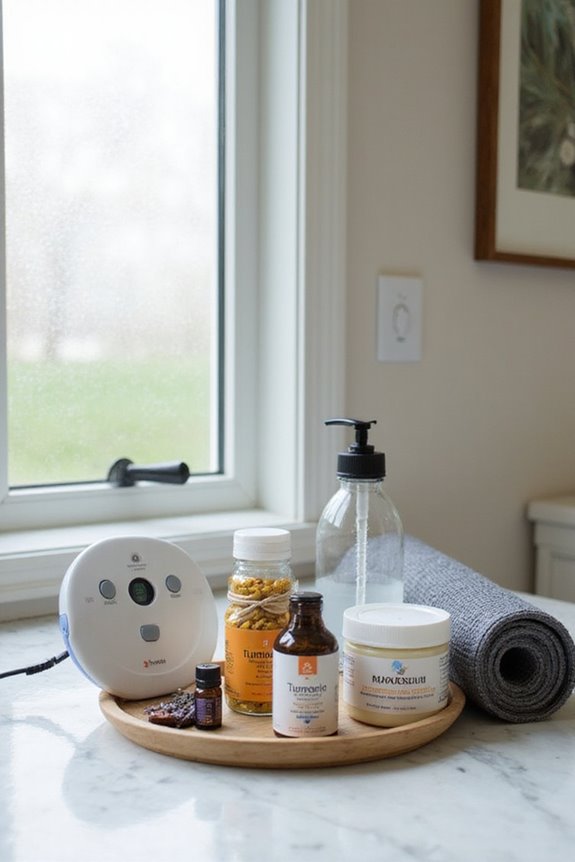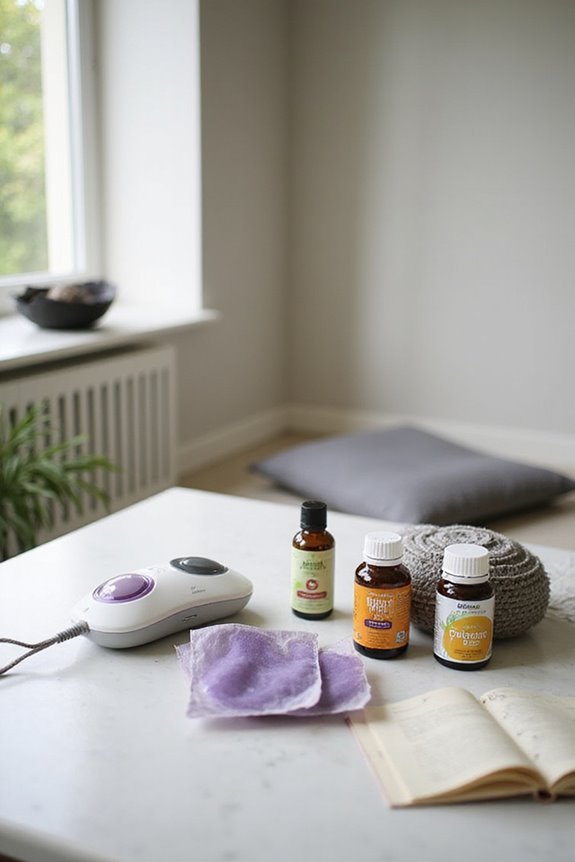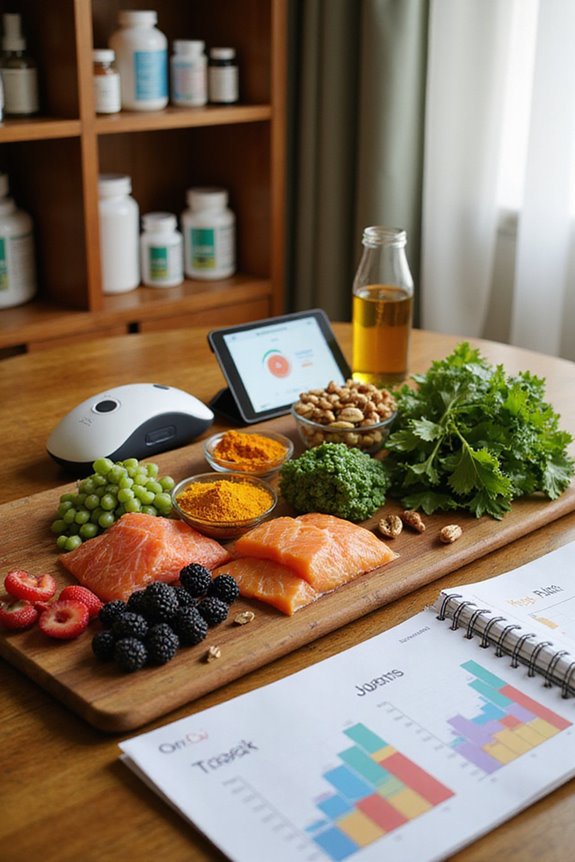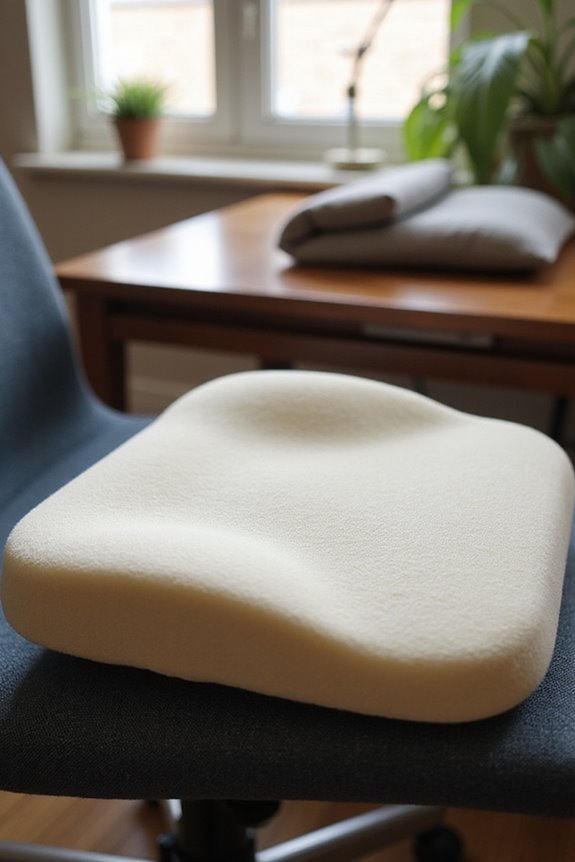Menopause greatly influences chronic pain conditions in women. Approximately 25% of women aged 40-60 report chronic pain, with hormonal fluctuations contributing to increased pain sensitivity. Common pain types include fibromyalgia, migraines, and osteoarticular pain. Estrogen and progesterone levels affect pain perception through neurochemical pathways. Additionally, mood fluctuations can amplify pain intensity, while effective coping strategies and social support play essential roles in pain management. Understanding these dynamics provides valuable insights into managing menopausal pain. Further information can enhance comprehension.
Key Takeaways
- Menopause can exacerbate chronic pain conditions due to hormonal fluctuations, particularly the decrease in estrogen and progesterone levels.
- Many women experience increased sensitivity to pain during menopause, leading to intensified fibromyalgia and migraines.
- Psychological factors, such as mood swings and stress, can amplify pain perception and tolerance during menopause.
- Chronic pain conditions like osteoarticular pain and lower back pain are reported at higher rates among menopausal women.
- Hormone Replacement Therapy (HRT) and alternative therapies may help alleviate chronic pain symptoms associated with menopause.
Understanding Menopause and Its Symptoms
Understanding menopause and its accompanying symptoms is essential for recognizing the changes that occur during this natural life shift. Menopause symptoms primarily stem from hormonal fluctuations, particularly the decline of estrogen and progesterone.
Key menopause symptoms include:
- Irregular menstrual cycles: Periods may become unpredictable, with variations in flow and frequency.
- Vasomotor symptoms: Hot flashes and night sweats can disrupt daily life and sleep quality.
- Cognitive changes: Difficulty concentrating and memory lapses may arise alongside mood swings, fueled by hormonal changes.
These symptoms can persist for several years, particularly during perimenopause, which averages four years. Understanding these changes fosters awareness and support, emphasizing the importance of acknowledging this significant shift in women’s health.
Chronic Pain Prevalence Among Midlife Women

Chronic pain greatly impacts the health and well-being of midlife women, particularly during the menopausal change. Approximately 25% of women aged 40-60 report experiencing chronic pain, a figure that exceeds the 23% prevalence rate in men.
Key points include:
- Gender Differences: Women experience higher rates of chronic pain due to hormonal changes and psychosocial factors.
- Incidence Rates: In 2020, there were 52.4 new chronic pain cases per 1,000 person-years among adults.
- Cultural Influences: Social norms around pain expression further affect reported prevalence rates.
- Rural Populations: Chronic pain is more common in rural areas, revealing the need for targeted pain management strategies.
Understanding these factors is essential for addressing chronic pain in midlife women.
Types of Chronic Pain Associated With Menopause

Menopause considerably influences the types of chronic pain experienced by women, with various conditions emerging or worsening during this life stage.
- Fibromyalgia Symptoms: Many women report amplified fibromyalgia symptoms, characterized by widespread musculoskeletal pain and increased pain sensitivity.
- Migraine Triggers: Hormonal fluctuations during menopause can instigate new migraines or exacerbate existing ones, affecting approximately 38% of women.
- Osteoarticular Pain: About 31% of menopausal women experience osteoarticular pain, often due to estrogen loss, leading to joint stiffness and increased vulnerability to conditions like osteoarthritis.
- Spinal Degeneration: Chronic neck and lower back pain may arise from spinal degeneration linked to reduced estrogen, affecting 21% of this population.
- Pelvic Discomfort & Vulvar Pain: Hormonal changes can lead to pelvic discomfort and vulvar pain, complicating daily life for many women during menopause.
Hormonal Influences on Pain Perception

Hormonal fluctuations greatly impact pain perception, particularly during the menopausal shift.
- Estrogen fluctuations lead to increased pain sensitivity, especially as levels decline, correlating with heightened severity in conditions like fibromyalgia and rheumatoid arthritis.
- Progesterone effects, characterized by fluctuating levels, can also amplify pain sensitivity, particularly in low estrogen states.
- The hormonal balance between estrogen and progesterone is essential for effective pain modulation.
- These hormones interact with neurochemical pathways, influencing pain processing and inflammatory responses.
- During menopause, chronic pain intensity often increases due to central sensitization, exacerbated by hormonal changes.
- Managing menopause symptoms may require a holistic approach, including hormone therapy, to address the complexities of chronic pain linked to these hormonal shifts.
The Role of Sleep Disturbances in Pain Management

Sleep disturbances represent a significant concern for women during the menopausal changeover, impacting both overall health and pain management.
Prevalence and Impact
- Approximately 50-60% of menopausal women report sleep problems.
- Insomnia symptoms nearly double, affecting over 60% of postmenopausal women.
Effects on Pain Sensitivity****
- Poor sleep quality heightens pain sensitivity and worsens chronic pain conditions, such as fibromyalgia and arthritis.
- Fragmented sleep interrupts restorative sleep, impairing pain modulation pathways.
Physiological Mechanisms
- Hormonal fluctuations, including declining estrogen, contribute to sleep disturbances and chronic inflammation.
- Sleep apnea exacerbates systemic inflammation, impacting analgesic efficacy.
Management Implications
- Poor sleep quality correlates with increased reliance on analgesics and reduced treatment effectiveness.
- Addressing sleep disturbances is vital for improving pain management outcomes in menopausal women.
Psychological Factors Impacting Pain During Menopause
Psychological factors greatly influence pain experiences during the menopausal change, as various emotional and cognitive responses can modulate pain perception.
- Mood Fluctuations: Increased mood instability can amplify pain intensity and reduce tolerance.
- Psychological Resilience: Higher resilience correlates with lower pain severity and enhanced coping mechanisms.
- Coping Mechanisms: Strategies such as mindfulness and cognitive reframing are effective in managing chronic pain.
- Stress Management: Chronic stress contributes to heightened pain sensitivity; therefore, stress reduction techniques are essential.
- Cognitive Appraisal: Negative beliefs about pain can worsen experiences, while effective emotional regulation aids in distress reduction.
Together, these psychological factors underscore the necessity of integrated approaches to manage pain during menopause, fostering improved health outcomes.
Social Support and Its Influence on Chronic Pain
Social support plays an essential role in the management of chronic pain, considerably influencing both perception and coping strategies.
- Emotional support from family and friends fosters empathy, reducing perceived pain intensity and alleviating emotional distress.
- Positive interactions can trigger endorphins, enhancing pain modulation.
Practical assistance, such as help with daily tasks, lessens physical burdens on individuals, allowing for increased activity levels.
– Supportive environments correlate with better adherence to treatment plans and reduced reliance on medication.
Additionally, peer support groups facilitate shared experiences and coping strategies, mitigating feelings of isolation.
– Overall, strong social networks are associated with decreased emotional distress, enhanced resilience, and improved pain management capacities.
The interplay of emotional and practical support considerably affects chronic pain experiences.
Demographics of Menopause-Related Chronic Pain
The demographics of menopause-related chronic pain reveal significant patterns that warrant attention.
- Age Group: Midlife women (ages 45-64) report the highest rates of chronic pain, with 52% of midlife women veterans experiencing this issue.
- Prevalence: Among naturally postmenopausal women, chronic pain prevalence is approximately 42-45%.
- Symptom Burden: Women with menopause symptoms face nearly double the odds of chronic pain.
- Race and Ethnicity: Chronic pain modeling indicates demographic variations, yet specific racial prevalence requires further study.
- BMI and Mental Health: Higher body mass index (BMI) correlates with increased chronic pain risk, while mental health issues exacerbate this prevalence.
- Veteran Status: Women veterans exhibit higher chronic pain rates due to unique health profiles and stressors.
Treatment Strategies for Managing Pain During Menopause
Managing pain during menopause requires a multifaceted approach that incorporates various treatment strategies.
HRT Benefits: Hormone Replacement Therapy can alleviate chronic pain by replenishing estrogen levels, reducing joint stiffness and muscle aches.
Physical Therapy: Tailored Physical Therapy improves joint mobility and muscle strength, enhancing pain management.
Pain Medications: Nonsteroidal anti-inflammatory drugs (NSAIDs) and acetaminophen serve as effective short-term pain relief options.
Dietary Modifications: A diet rich in anti-inflammatory foods, adequate hydration, and weight management can mitigate pain severity.
Exercise Routines: Consistent low-impact exercise, such as walking or yoga, correlates with decreased musculoskeletal pain.
Alternative Therapies: Acupuncture, massage, and mind-body practices provide additional avenues for pain relief and improved quality of life.
Future Directions for Research in Menopausal Pain Management
Research in menopausal pain management is increasingly recognized as a critical area requiring further exploration. This includes addressing barriers to care, particularly in low- and middle-income countries, where access to pain management interventions is limited.
Future directions for research should focus on:
- Understudied Populations: Investigating pain experiences in rural versus urban settings and across diverse ethnic and cultural backgrounds.
- Mechanisms Linking Menopause and Pain: Examining hormonal influences and neuroendocrine changes that exacerbate pain.
- Personalized Interventions: Developing tailored hormone therapies and exploring non-hormonal options to cater to individual patient needs.
- Impact on Comorbidities: evaluating how pain management strategies influence cardiovascular disease and quality of life metrics.
Long-term studies are essential to understand the efficacy and implications of these interventions.
Frequently Asked Questions
Can Menopause Symptoms Trigger New Chronic Pain Conditions?
Menopause triggers increased pain sensitivity, often leading to the onset of new chronic pain conditions. Women frequently report heightened discomfort and musculoskeletal issues, reflecting the profound impact hormonal changes have on their overall pain experience.
How Can Diet Influence Menopause-Related Pain?
Dietary changes, rich in fruits, vegetables, and omega-3s, contrast with refined carbohydrates that may heighten pain. Nutritional supplements, like vitamin B6 and zinc, can further support hormonal balance, fostering relief during menopause-related discomfort.
Are There Natural Remedies for Menopause-Related Chronic Pain?
Natural remedies for menopause-related chronic pain include herbal supplements like evening primrose oil and acupuncture therapy, which may provide relief and foster a sense of community among those seeking holistic approaches to managing their symptoms.
What Role Does Exercise Play in Managing Menopausal Pain?
Exercise plays an essential role in managing menopausal pain, with strength training enhancing muscle support and bone density, while aerobic activities improve overall fitness and reduce discomfort, fostering a sense of community and belonging among participants.
How Can Women Advocate for Better Pain Management During Menopause?
Like a ship steering through a storm, women can advocate for better pain management by documenting symptoms, asking targeted questions, and seeking multidisciplinary care, fostering a supportive environment that enhances patient advocacy and collective resilience.





